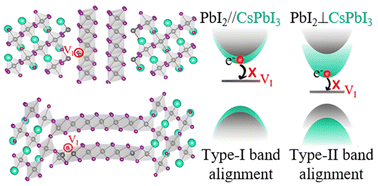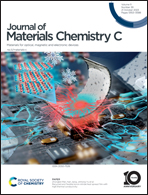Impacts of PbI2 on high-efficiency perovskite solar cells: exploring intercalation orientations and defects†
Abstract
Excess lead iodide (PbI2) is commonly found in high-efficiency perovskite solar cells (PSCs). However, the impacts of the band alignments, passivation effects and defects caused by PbI2 on the photovoltaic performance of PSCs remain undisclosed. Here, using first-principles calculations, we reveal that the intercalation orientation of the layered PbI2 and interfacial terminations of PbI2/perovskite dominate the functions of PbI2 in perovskites. Among the PbI2/CsPbI3 heterointerfaces with various terminations, the PbI2‖CsPbI3–CsI, PbI2‖CsPbI3–Pb and PbI2–Pb⊥CsPbI3–I heterointerfaces are energetically favorable, which are formed by the layered PbI2 parallelly (‖) interfaced with the CsI- and Pb-terminated (1 1 1) planes of CsPbI3 and the Pb-terminated PbI2 vertically (⊥) interfaced with the I-terminated (1 1 1) plane of CsPbI3, respectively. The parallel and vertical intercalations of the layered PbI2 in CsPbI3 result in moderate type-I and pronounced type-II band alignments, respectively, explaining the discrepancies observed in experiments. The defect-free PbI2 exhibits potential passivation effects in the perovskite, while the easily formed VI and Ii defects in photoactive PbI2 at the interface can result in deep levels. Nonadiabatic molecular dynamics simulations reveal that the deep-level at the PbI2‖CsPbI3–CsI heterointerface leads to severe carrier nonradiative recombination, while those at the PbI2‖CsPbI3–Pb and PbI2–Pb⊥CsPbI3–I heterointerfaces are not active recombination centers. To retain the beneficial effects of PbI2 on CsPbI3 solar cells by improving carrier lifetime and efficient carrier transfer, it is a promising approach to promote the parallel intercalation of thin-layered PbI2 with the Pb-terminated (1 1 1) plane of the perovskite (PbI2‖CsPbI3–Pb). This study provides a comprehensive understanding of the influence of excess PbI2 on perovskite and offers insights for optimizing its function in achieving high-efficiency PSCs.

- This article is part of the themed collections: 2023 Journal of Materials Chemistry C HOT Papers and #MyFirstJMCC


 Please wait while we load your content...
Please wait while we load your content...